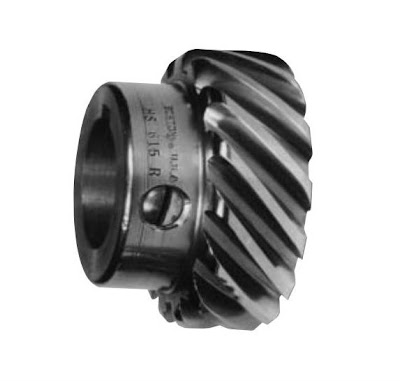HELICAL GEARS OPERATING ON NON-PARALLEL SHAFTS
When helical gears are operated on non-parallel shafts, the tooth load is concentrated at a specific point. The result:
very small loads will produce high pressures. In addition, the sliding velocity is usually quite high; this, combined with the aforementioned concentrated pressure may produce excessive wear, especially if the teeth are not well-lubricated.
For these reasons, the tooth load, which may be applied to such drives (where helical gears are operating on non-parallel shafts) is very limited and of uncertain value. As a result, it is best to determine the “correct” tooth load through “trial and error” under actual operating conditions. If one of the gears is bronze, the contact area (and corresponding load-carrying capacity) may be increased by allowing the gears to “run-in” in their operating position, under loads which gradually increase to the maximum expected load.
LUBRICATION
Helical gears should be properly lubricated to: minimize wear; prevent the generation of excessive heat; improve efficiency through the reduction of friction between the mating tooth surfaces; reduce noise; and inhibit the formation of rust.
Good lubrication depends on the formation of a film thick enough to prevent contact between the mating surfaces.
The relative motion between gear teeth helps to produce the necessary film from the small wedge formed adjacent to the area of contact. It is important that an adequate supply of the correct lubricant is properly applied. Keep the following lubrication guidelines in mind:
• A straight mineral oil lubricant should be used for most parallel shaft applications. Under heavy load conditions, mild extreme-pressure (E.P.) lubricants are suggested.
• Helical gears operating at right angles must always be well-lubricated. Extreme pressure (E.P.) lubricants are recommended.
• Extreme pressure (E.P.) lubricants are not recommended on bronze gears.
Keypoints of Helical Gears :
• Helical gears are similar to spur gears except their teeth are cut at a angle (45º) to the axis hole
• Helical gears are used to connect parallel shafts or shafts at right angles (90º)
• Helical gears connecting parallel shafts will run more smoothly and quietly than spur gears
• Helical gears used to connect parallel shafts must have the same pitch, pressure angle, and helix angle and be of opposite hand (one Right Hand and one Left Hand)
• Helical gears come only in two styles: (A) Plain Style - No hole (B) Plain Style with hub

